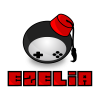-
Posts
487 -
Joined
-
Last visited
-
Days Won
2
Ezelia last won the day on May 31 2015
Ezelia had the most liked content!
Contact Methods
-
Website URL
http://ezelia.com/
-
Twitter
@Ezelia_
Profile Information
-
Gender
Not Telling
Ezelia's Achievements
-
 marcioramos reacted to a post in a topic:
Pixi.js Showcase
marcioramos reacted to a post in a topic:
Pixi.js Showcase
-
 jamespierce reacted to a post in a topic:
Tutorial : Handling game scenes and screen scaling with Pixi
jamespierce reacted to a post in a topic:
Tutorial : Handling game scenes and screen scaling with Pixi
-
 bitelchux reacted to a post in a topic:
Germiz - an HTML5 puzzle game
bitelchux reacted to a post in a topic:
Germiz - an HTML5 puzzle game
-
ivan.popelyshev started following Ezelia
-
 ivan.popelyshev reacted to a post in a topic:
Pixi.js Showcase
ivan.popelyshev reacted to a post in a topic:
Pixi.js Showcase
-

Eureca.io v0.6.4 : NodeJS library for HTML5 multiplayer games
Ezelia replied to Ezelia's topic in Coding and Game Design
Hi @blackgames Thank you for using eureca.io, I'm curious to see the game using eureca.io, and very happy to know that it helped you in your game creation. About the /eureca.js file, you can prefix it with the server url : if your game server is mygameserver.com, you can use http://mygameserver.com/eureca.js or you can open the /eureca.js in your browser, save it, and include it to your cocoonjs package then reference it as a static file. make a test and let me know- 4 replies
-
- Multiplayer
- WebRTC
-
(and 3 more)
Tagged with:
-
No, nothing to configure. Phaser 2.x do not have its own rendering engine, it use Pixi renderer. EZGUI detect if you are using Phaser and adapt automatically.
-
the initialization process only load EZGUI resources to make sure they are available for components. then, for each component, there is a processing for JSON settings, then a creation of the component, and finaly the component is cached. this processing, is only done once, then everything is handled by Pixi or Phaser . the EZGUI component become a Phaser DisplayObject with specific interactions.
-
There is no real difference between Phaser button and EZGUI button, both user sprite for rendering and eventmanager to catch events. But for each component, EZGUI create a specific phaserGroup to isolate EZGUI specific complement from game components .... this is not supposed to reduce performance (it add a hierarchi level but will surely not lead to a drop of 30% !) also EZGUI will use the current active renderer, if you use canvas2D it'll use canvas2D too. I never tested on iOS devices, maybe there is some difference in behaviour .... do you have any way to monitor CPU performance and memory allocations ?
-
Hi @caragones, I have noticed similar case in a game where I used an HTML5 wrapper (similar behavior on both Cordova and Crosswalk). For me it was only happening for GUIs taking the whole screen, the game performance itself was not affected .... I thought that it's related to cordova behaviour : maybe limitting RAF calls when nothing change on the screen leading to fake FPSmeter drop ? and I stoped investigations there. I don't think that EZGUI itself will cause performance drop because of coputation, because each EZGUI control is constructed once, and cached using Pixi bitmap cache. so the build code (which require CPU time is only executed once). it can also be the fact that drawing a big texture (the cached bitmap) can degrade performance, but in this case it'll be more related to Pixi. if you think it really degrade game performance, I'd like to investigate more. but I need more information. have you tried Chrome profiler to see if some code is using lot of CPU time (also check heap allocations)
-
 Befive.Info reacted to a post in a topic:
EZGUI : The missing GUI Library for Pixi and Phaser
Befive.Info reacted to a post in a topic:
EZGUI : The missing GUI Library for Pixi and Phaser
-
 Pooya72 reacted to a post in a topic:
EZGUI : The missing GUI Library for Pixi and Phaser
Pooya72 reacted to a post in a topic:
EZGUI : The missing GUI Library for Pixi and Phaser
-
 yahiko reacted to a post in a topic:
EZGUI : The missing GUI Library for Pixi and Phaser
yahiko reacted to a post in a topic:
EZGUI : The missing GUI Library for Pixi and Phaser
-
Just pushed a new version to git repository. this one mainly fix Phaser 2.4 compatibility. since some Pixi classes and structures was removed in Phaser 2.4, this version allow you to use EZGUI with Phaser 2.4 by including a compatibility script. compiled version and compatibility scripts are available here : https://github.com/Ezelia/EZGUI/tree/master/dist also added two usage examples : https://github.com/Ezelia/EZGUI/blob/master/examples/Phaser/phaser-2.4.htmlhttps://github.com/Ezelia/EZGUI/blob/master/examples/game/phaser-2.4.html
-
 Sturb reacted to a post in a topic:
EZGUI : The missing GUI Library for Pixi and Phaser
Sturb reacted to a post in a topic:
EZGUI : The missing GUI Library for Pixi and Phaser
-
Well I think that thing are much easier with the PixiV3. I mainly wrote this tutorial by the time where Pixi.Stage was a special container, now with Pixi v3, Stage no more exist, it's just a container like others. so the easiest way to handle scenes is to crete a container for each scene, and put all your stuff into it, then hide/show the container depending on what scene you wan't to display. it's really very simple with Pixi v3. are you having some specific issue which is adressed by the tutorial but not with the method described above ?
-
 george reacted to a post in a topic:
Pixi.js Showcase
george reacted to a post in a topic:
Pixi.js Showcase
-
This is the isometric engine I'm working on, it use Pixijs v3 for rendering. Nothing playable for now, but I'll share an online demo soon
-
Hello @omarojo, please note that this Tutorial is very old and outdated it's about Pixijs 1.6 and the last Pixijs version is 3 ! I'll be surprised if it's still working with new Pixi version about Typescript usage, I used it because the structure of the code is Object Oriented and TypeScript support OOP very well, the code logic itself do not differ ... I'll update the tutorial for new Pixi version when I have some time, and I'll write it in both TypeScript and Javascript
-
 GourmetGorilla reacted to a post in a topic:
Welcome to the Pixi.js forum
GourmetGorilla reacted to a post in a topic:
Welcome to the Pixi.js forum
-

Eureca.io v0.6.4 : NodeJS library for HTML5 multiplayer games
Ezelia replied to Ezelia's topic in Coding and Game Design
Hi @horkoda sorry for the very late reply, for some reason I didn't get notification of post replies on this topic. about your questions, there is absolutely no problem to use websocket and webRTC side by side, (this is btw usually used by WebRTC apps to initialize the connection). the only thing you'll need here is to create a separate server instance for each, and of course listen on different ports. about WebRTC issues, you can encounter incompatibility issues on old browsers or on some mobile browsers since it's quite new standard. I encountered some strange connection loss but it was rare, can't say if it's because of unreliability nature of webRTC or something else. if you encounter any problem feel free to open issue on github repository hope it'll help.- 4 replies
-
- Multiplayer
- WebRTC
-
(and 3 more)
Tagged with:
-
Good catch ! this is a bug in text property I just pushed a fix update.
-
a first version of input control was pushed . this is the live demo to see how it work : http://ezgui.ezelia.com/examples/07-input/1-simple.html it's still not perfect but is usable on both desktop and mobiles. let me know if it works fine for you, and feel free to open issue on Github or post here if you encounter any bug
-
Hi sanafa, thank you for you comment. the input component is the one I'm working on now it'll be added in the next update very soon. just trying to figure out the best and cleanest approach to make it, so it support both desktop and mobile devices. follow the developement repo on github since it's updated more frequently than the zip package.
-
fix published, you can now use the latest dev version and remove the workaround (https://github.com/Ezelia/EZGUI/tree/master/dist)
-
got it here is a quick and dirty patch. I'll make a cleaner version in the next EZGUI update (maybe tonight). Add the following code to your script (make sure it'll be executed after ezgui.js) function isMasked(x, y, obj) { var parent = obj.parent; if (parent == null) return false; if (!parent.worldTransform || !parent.guiMask) return isMasked(x, y, parent); var wratio = Phaser.GAMES[0].scale.width/Phaser.GAMES[0].width; var hratio = Phaser.GAMES[0].scale.height/Phaser.GAMES[0].height; var tx = (parent.worldTransform.tx + parent.guiMask.x) * wratio; var ty = (parent.worldTransform.ty + parent.guiMask.y) * hratio; var w = parent.guiMask.width * wratio; var h = parent.guiMask.height * hratio; if (x < tx || y < ty || x > tx + w || y > ty + h) return true; return isMasked(x, y, parent); }EZGUI.utils.isMasked = isMasked;let me know if it fixe all the scaling issues nice game btw let me know when you publish it. I'll add some projects using EZGUI to the showcase in the official page and project wiki.





